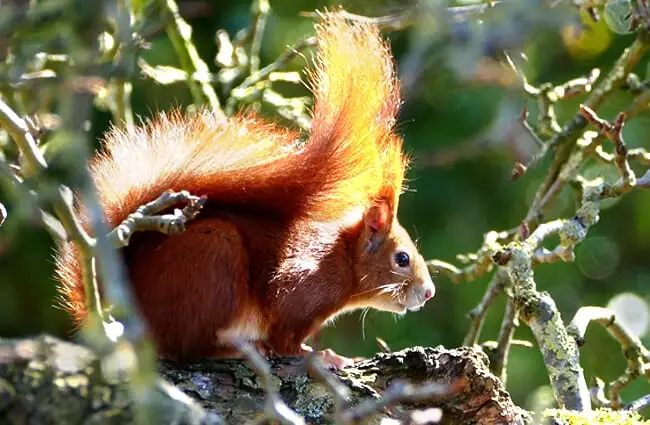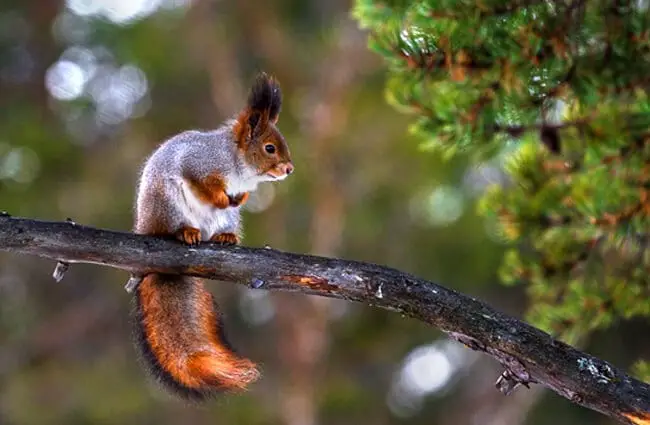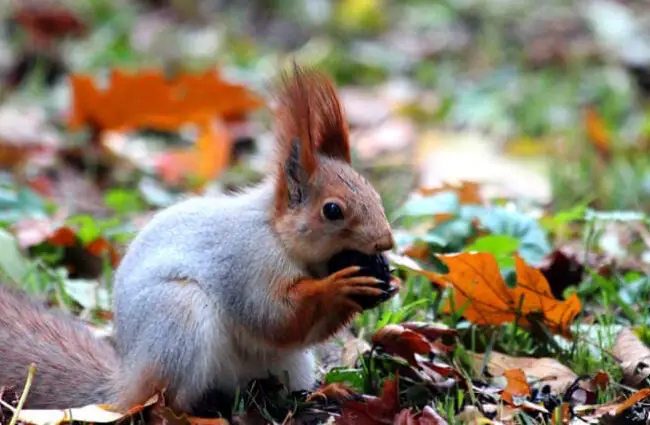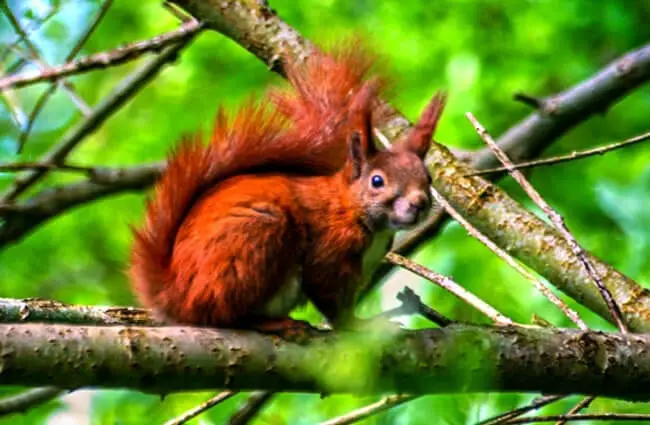A Closer Look at the Red Squirrel: Nature’s Agile Acrobat
The red squirrel, a charismatic and energetic member of the Sciuridae family, holds a special place in the hearts of nature enthusiasts and within the ecosystems it inhabits. From its distinctive reddish fur to its impressive acrobatic skills, this captivating creature offers a wealth of fascinating information. This article delves into the world of the red squirrel, exploring its biology, behavior, habitat, and ecological role, providing insights for students, animal lovers, and aspiring zoologists alike.

Basic Biology and Identification
The Eurasian red squirrel Sciurus vulgaris is instantly recognizable by its vibrant reddish coat, though color can vary depending on season and location, ranging from bright orange to almost black. Its bushy tail, approximately the same length as its body, isn’t just for show; it aids in balance during leaps and serves as a warm covering in colder months. Adults typically measure between 24 and 33 centimeters in length, with a weight ranging from 250 to 400 grams. Sharp claws enable it to expertly navigate tree bark, and its pupils are adapted for good vision in both bright sunlight and dim forest conditions.
Habitat and Distribution
Historically found throughout Europe and northern Asia, the red squirrel now faces competition from the introduced grey squirrel in many areas, particularly in the United Kingdom. Its preferred habitat is coniferous and mixed woodlands, providing abundant sources of cones and seeds. They thrive in mature forests with a complex structure of trees, allowing for safe movement and refuge from predators. Red squirrels are adept climbers and spend most of their lives in the canopy, rarely venturing far from trees. They establish home ranges, which vary in size depending on food availability and population density. In areas where grey squirrels are absent, red squirrel populations remain robust, demonstrating their adaptability and resilience.

Finding Red Squirrels in the Wild
If you’re hoping to spot a red squirrel, focus your efforts on coniferous forests in Scotland, Northern England, Wales, and parts of Ireland. Look for evidence of their presence such as chewed cones, known as ‘middens,’ and partially eaten nuts. Early mornings and late afternoons are typically the most active times for foraging. Patience and a keen eye are essential, as red squirrels are naturally cautious creatures. Remember to observe from a distance and avoid disturbing their natural behavior. Binoculars can be extremely helpful for observing them from afar.
Diet and Foraging Behavior
Red squirrels are primarily seed eaters, with a particular fondness for the seeds found within pine, spruce, and larch cones. They also consume nuts, berries, buds, shoots, fungi, and occasionally insects and bird eggs. A key foraging strategy is ‘scatter hoarding,’ where they bury individual seeds and nuts in numerous locations to ensure a food supply throughout the winter. Their excellent spatial memory helps them relocate these hidden caches, though not all are recovered. This behavior plays a significant role in forest regeneration, as seeds left unrecovered germinate and grow into new trees.

Reproduction and Life Cycle
Red squirrels typically breed in late winter or early spring, with a gestation period of around 38 to 44 days. Females usually produce one to four kits in a drey, a spherical nest constructed from twigs, leaves, and moss, often built high in the branches of a tree. Kits are born blind and helpless, relying entirely on their mother for care. They develop rapidly, opening their eyes after about four weeks and becoming increasingly independent. Young squirrels typically leave the drey in the autumn and establish their own territories, though many don’t survive their first winter due to predation or starvation. Red squirrels typically live for around three to seven years in the wild.
Ecological Role and Interactions
Red squirrels play a vital role in forest ecosystems, contributing to seed dispersal and forest regeneration. Their foraging activities also help to maintain the health of trees by removing damaged cones and buds. They are prey for a variety of predators, including pine martens, foxes, stoats, and birds of prey. The introduction of the grey squirrel has had a significant impact on red squirrel populations, as grey squirrels are larger, more aggressive, and carry a virus called squirrel parapoxvirus, to which red squirrels are highly susceptible. This virus causes severe skin lesions and often leads to death.

Conservation Status and Threats
Red squirrel populations are declining in many parts of their range, primarily due to habitat loss, competition from grey squirrels, and disease. Conservation efforts focus on habitat restoration, grey squirrel control, and vaccination programs to protect red squirrels from squirrel parapoxvirus. Creating connected woodland habitats is crucial to allow red squirrels to move freely and access food resources. Public awareness campaigns also play a vital role in promoting red squirrel conservation.
Red Squirrels and Human Interactions
Historically, red squirrels were hunted for their fur, but this practice has largely ceased. Today, the main human impact on red squirrels is through habitat destruction and the introduction of non native species. Observing red squirrels in their natural habitat can be a rewarding experience, but it’s important to do so responsibly, avoiding disturbance and respecting their natural behavior. Providing supplementary food during harsh winters can help support local populations, but it’s important to use appropriate food and avoid creating dependence.

Caring for Red Squirrels in Captivity
Caring for red squirrels in captivity requires a specialized environment that mimics their natural habitat. Enclosures should be spacious and include plenty of climbing opportunities, such as branches, ropes, and platforms. A varied diet consisting of nuts, seeds, fruits, vegetables, and occasional protein sources is essential. Enrichment activities, such as puzzle feeders and foraging toys, are crucial to stimulate their natural behaviors and prevent boredom. Regular veterinary checkups are essential to monitor their health and well being. Strict hygiene protocols should be followed to prevent the spread of disease. It is crucial to avoid over handling, as this can cause stress.
Fascinating Facts About Red Squirrels
- Red squirrels can leap up to 10 times their own body length.
- They have sharp, non retractile claws that allow them to climb trees with ease.
- Red squirrels cache thousands of seeds each year, contributing to forest regeneration.
- They communicate using a variety of vocalizations, including chirps, trills, and chatters.
- Their bushy tail helps them maintain balance during leaps and provides warmth in winter.
- Red squirrels are primarily diurnal, being most active during daylight hours.

The red squirrel, a testament to nature’s ingenuity and resilience, continues to captivate and inspire. By understanding its biology, behavior, and ecological role, we can better appreciate this remarkable creature and work towards its conservation for generations to come.

![Red Angus Closeup of a beautiful Red Angus cowPhoto by: U.S. Department of Agriculture [pubic domain]https://creativecommons.org/licenses/by/2.0/](https://animals.net/wp-content/uploads/2020/03/Red-Angus-4-238x178.jpg)




![Red Angus Closeup of a beautiful Red Angus cowPhoto by: U.S. Department of Agriculture [pubic domain]https://creativecommons.org/licenses/by/2.0/](https://animals.net/wp-content/uploads/2020/03/Red-Angus-4-100x75.jpg)

